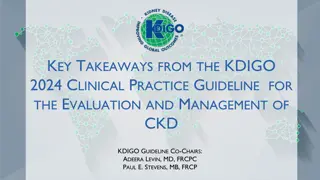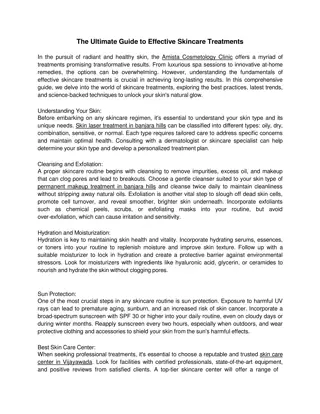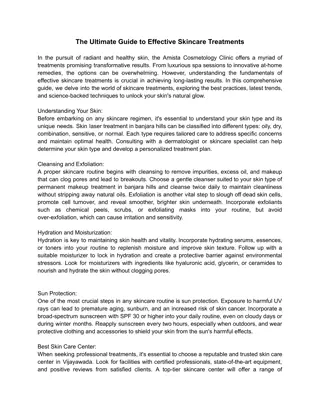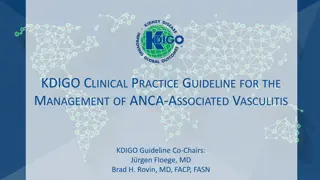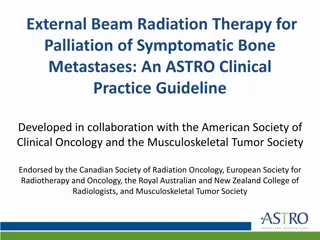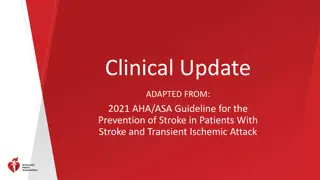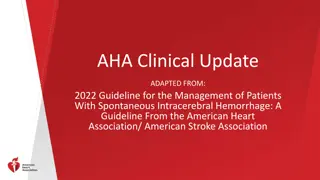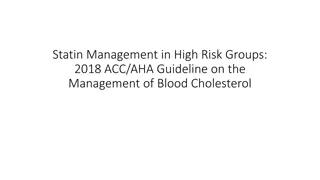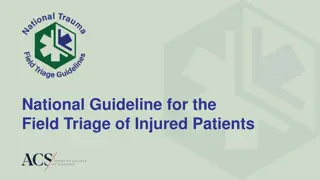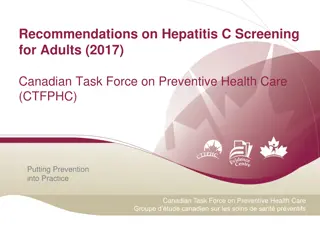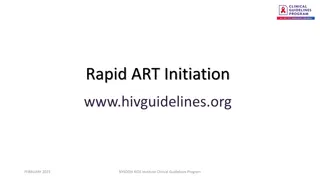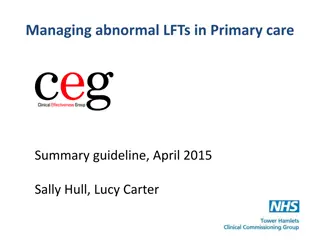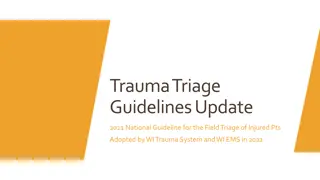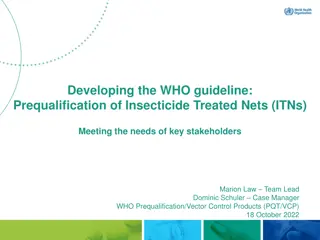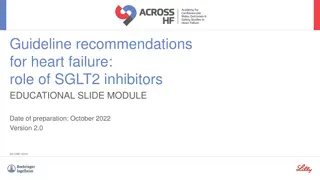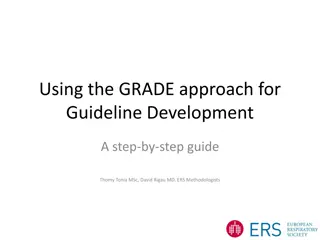Optimizing Foundational Treatments for HFrEF: Guideline Recommendations and Implementation Strategies
Highlighting the current guideline recommendations for treating patients with Heart Failure with Reduced Ejection Fraction (HFrEF), this educational slide module emphasizes the importance of implementing the recommended therapies effectively. It covers the foundational treatments recommended by various cardiovascular societies, including ACE inhibitors, ARNi, beta-blockers, SGLT2 inhibitors, and MRAs. The module aims to help healthcare professionals understand the significance of rapid initiation and appropriate sequencing of these therapies to optimize outcomes for HFrEF patients based on recent clinical trial data and proposed strategies.
Download Presentation

Please find below an Image/Link to download the presentation.
The content on the website is provided AS IS for your information and personal use only. It may not be sold, licensed, or shared on other websites without obtaining consent from the author.If you encounter any issues during the download, it is possible that the publisher has removed the file from their server.
You are allowed to download the files provided on this website for personal or commercial use, subject to the condition that they are used lawfully. All files are the property of their respective owners.
The content on the website is provided AS IS for your information and personal use only. It may not be sold, licensed, or shared on other websites without obtaining consent from the author.
E N D
Presentation Transcript
Optimising use of foundational treatments for HFrEF EDUCATIONAL SLIDE MODULE December 2022 SC-CRP-12764
Module objectives The aims of this educational slide module are to: 1 Highlight the current guideline recommendations for treatment of patients with HFrEF 2 Understand the current situation with regards to guideline implementation 3 Review relevant data from clinical trials 4 Review proposed strategies for treatment optimisation 2
Optimising use of foundational treatments for HFrEF Current implementation of recommended HFrEF therapies Conventional and rapid sequencing of HFrEF therapies Considerations for sequencing of HFrEF therapies Summary
There are four foundational therapies for the treatment of patients with HFrEF1 3 American Heart Association American College of Cardiology Heart Failure Society of America ARNi/ ACEi Beta blocker As highlighted in recent guidelines from: European Society of Cardiology SGLT2 inhibitor MRA Canadian Cardiovascular Society Canadian Heart Failure Society MRA, mineralocorticoid receptor antagonist; SGLT2, sodium-glucose co-transporter-2 1. McDonagh TA et al. Eur Heart J 2021;42:3599; 2. Heidenreich PA et al. J Am Coll Cardiol 2022;79:e263; 3. McDonald M et al. Can J Cardiol 2021;37:531 4
2021 ESC Guidelines and the 2022 AHA/ACC/HFSA Guideline recommend rapid initiation of the four foundational therapies in HFrEF New Class 1 recommendations in HFrEF: SGLT2 inhibitors are recommended irrespective of the presence of type 2 diabetes1 3 In patients with HFrEF, the four foundational drug therapies* should be initiated quickly1,2 and either simultaneously at low doses or sequentially guided by clinical or other factors3 LVEF >40% ESC Guidelines emphasise the importance of tailored management according to HFrEF phenotype and patient characteristics1,2 See slide notes for definitions of classes of recommendation and levels of evidence. *SGLT2 inhibitors, ACEi/ARB/ARNi, MRA, beta blocker. AHA, American Heart Association; ESC, European Society of Cardiology; HFSA, Heart Failure Society of America; MRA, mineralocorticoid receptor antagonist; SGLT2, sodium-glucose co-transporter-2 1. McDonagh TA et al. Eur Heart J 2021;42:3599; 2. Gardener RS. New recommendations for the treatment of HFrEF. Oral presentation at ESC 2021; 3. Heidenreich PA et al. J Am Coll Cardiol 2022;79:e263 5
Cross-trial analysis:* Estimating benefits of comprehensive vs conventional use of foundational HFrEF treatments Treatment benefits on overall survival and CV death or first HHF event-free survival with comprehensive disease- modifying vs conventional therapy Estimation of relative treatment effects of comprehensive disease-modifying pharmacological therapy on key cardiovascular events Comprehensive therapy Conventional therapy 16 14 12 10 20 HR (95% CI) CV death or first HHF 18 event-free survival Overall survival 16 14 12 10 CV death or first HHF 0.38 (0.30, 0.47) (years) (years) CV death 0.50 (0.37, 0.67) 8 6 4 2 0 8 6 4 2 0 HHF 0.32 (0.24, 0.43) All-cause mortality 0.53 (0.40, 0.70) event-free survival (years) 10 0.125 0.25 0.5 1 2 overall survival (years) 10 8 Favours comprehensive Favours conventional therapy Difference in Difference in 8 therapy 6 6 4 The comprehensive use of foundational therapies can improve life expectancy for the average 55-year-old patient with HFrEF by a median of 6 years compared with more limited conventional regimens 4 2 2 0 55 60 65 Age (years) 70 75 80 55 60 65 Age (years) 70 75 80 *Indirect comparisons of estimated treatment effects of comprehensive disease-modifying pharmacological therapy (ARNI, beta blocker, MRA, and SGLT2i) vs conventional therapy (ACEi or ARB and beta blocker) in patients with chronic HFrEF in three trials; EMPHASIS-HF (n=2737), PARADIGM-HF (n=8399) and DAPA-HF (n=4744); Estimated mean CV death or first HHF event free survival and overall survival in the conventional therapy group (EMPHASIS-HF control group) and the comprehensive therapy group for every age between 55 and 80 years; Treatment differences (data points), smooth estimate (solid line) and 95% CI of the smoothed estimate (shaded outer area) estimated for mean event free survival and overall survival with comprehensive vs conventional therapy for every age between 55 and 80 years after application of a locally weighted scatterplot smoothing procedure HHF, hospitalisation for heart failure; MRA, mineralocorticoid receptor antagonist; SGLT2, sodium-glucose co-transporter-2. Vaduganathan M et al. Lancet 2020;396:121 6
Despite guideline recommendations, HFrEF therapy is not currently optimised CHAMP-HF registry: use of guideline-directed therapy in patients with chronic HFrEF (n=3518) With contraindication Treated Without contraindication and not treated 100 26.2% 32.9% 39.1% 80 Frequency (%) 65.9% 60 86.1% 40 72.1% 66.8% 59.9% 20 33.1% 12.8% 1.8% 1.1% 0.2% 1.1% 1.1% 0 ACEi/ARB ARNi ACEi/ARB/ARNi Beta blocker MRA For each category, data reflect the proportion of the overall study population with an absolute contraindication, treated with any dose, and without an absolute contraindication but not treated MRA, mineralocorticoid receptor antagonist Greene SJ et al. J Am Coll Cardiol 2018;72:351 7
In contemporary clinical trials in HFrEF, patients frequently did not receive all classes of GDMT at baseline Patients with background ARNi or MRA at baseline 100.00% ARNi use MRA use 80.00% 71% 71% Patients (%) 60.00% 56% 40.00% 20.00% 19% Not 11% 0% applicable* 0.00% 2 1 3 EMPEROR-Reduced DAPA-HF PARADIGM-HF Comparison of studies should be interpreted with caution due to differences in study design, populations and methodology *ARNi was the experimental arm, therefore no patients had ARNi at baseline GDMT, guideline-directed medical therapy; MRA, mineralocorticoid receptor antagonist 1. Packer M et al. N Engl J Med 2020;383:1413; 2. McMurray JJV et al. N Engl J Med 2019;381:1995; 3. McMurray JJV et al. N Engl J Med 2014;371:993 8
Despite guideline recommendations and available evidence, improvement in treatment implementation is poor Patients receiving evidence-based treatments Patients survival over time Survival 30 days* 100 100 Beta blocker RAAS antagonist 80 80 Survival 1 year Survival (%) Usage (%) 60 60 MRA Survival 3 years 40 40 20 20 ICD CRT 0 0 2003 2004 2005 2006 2007 2008 2009 2010 2011 2012 2003 2004 2005 2006 2007 2008 2009 2010 2011 2012 Year of inclusion Year of inclusion In a large Swedish registry of HFrEF, implementation of evidence-based therapy did not increase meaningfully over time, which corresponded to a lack of improvement in outcomes *Only in-hospital patients; only patients registered in 2003 2010. CRT, cardiac resynchronisation therapy; ICD, implantable cardioverter defibrillator; MRA, mineralocorticoid receptor antagonist; RAS, renin angiotensin aldosterone system Thorvaldsen T et al. Eur J Heart Fail 2016;18:503 9
Optimising use of foundational treatments for HFrEF Current implementation of recommended HFrEF therapies Conventional and rapid sequencing of HFrEF therapies Considerations for sequencing of HFrEF therapies Summary
Conventional sequencing of foundational HFrEF treatments is time-consuming and inefficient Conventional sequencing ACEi/ARB Step 1 Uptitration to target doses at each step Beta blocker Step 2 Typically requires 6 months MRA Step 3 ARNi Step 4 SGLT2i Step 5 MRA, mineralocorticoid receptor antagonist; SGLT2i, sodium-glucose co-transporter-2 inhibitor McMurray JJV et al. Circulation 2021;143:875 11
New strategies are needed for more rapid sequencing of foundational HFrEF treatments New rapid sequencing strategy? ACEi/ARB Beta blocker MRA ARNi SGLT2i Points to consider: Each class reduces morbidity and mortality early after initiation Each therapy has an effect that is independent of dose or prior initiation of other therapies Low doses of each of the therapeutic classes have additive therapeutic efficacy Initiating low doses of all four foundational HFrEF therapies should be prioritised over conventional sequencing and dose escalation* *Most recommendations for rapid sequencing suggest that all therapy classes, in the absence of any contraindications, should be initiated within 4 weeks of identification of HFrEF MRA, mineralocorticoid receptor antagonist; SGLT2i, sodium-glucose co-transporter-2 inhibitor Sharma A et al. JACC Basic Transl Sci 2022;7:504 12
Proposal of algorithm for simultaneous initiation of foundational treatments for HFrEF starting at low doses Beta blocker MRA ARNi SGLT2i Low dose Low dose Low dose Standard dose Day 1 Titrate as tolerated Continue Continue Continue Days 7 14 Titrate as tolerated Titrate as tolerated Titrate as tolerated Continue Days 14 28 Titrate as tolerated Titrate as tolerated Continue Continue Days 21 42 Maintenance or additional titration of the four foundational therapies Consideration of EP device therapies or transcatheter mitral valve repair Consideration of add-on medications or advanced therapies, if refractory Manage comorbidities After day 42 EP, electrophysiological; MRA, mineralocorticoid receptor antagonist; SGLT2i, sodium-glucose co-transporter-2 inhibitor Greene SJ et al. JAMA Cardiol 2021;6:743 13
Alternative algorithm for rapid sequential initiation of foundational treatments for HFrEF Conventional sequencing Proposed rapid sequencing algorithm + ACEi/ARB Beta blocker SGLT2i Step 1 Beta blocker ARNi Step 2 MRA MRA Step 3 ARNi Step 4 All 3 steps achieved within 4 weeks Uptitration to target doses thereafter SGLT2i Step 5 MRA, mineralocorticoid receptor antagonist; SGLT2i, sodium-glucose co-transporter-2 inhibitor McMurray JJV et al. Circulation 2021;143:875 14
Optimising use of foundational treatments for HFrEF Current implementation of recommended HFrEF therapies Conventional and rapid sequencing of HFrEF therapies Considerations for sequencing of HFrEF therapies Summary
Risk of adverse events contributes to suboptimal implementation of GDMT in patients with HFrEF Tolerability challenges can include low blood pressure, low heart rate, impaired kidney function or hyperkalaemia Drug class Common side effects Hypotension Hypokalaemia Hypomagnesaemia Hyponatraemia Hyperuricaemia Hypovolaemia/dehydration Rise in creatinine, urea Diuretics Cough Hypotension Rise in urea, creatinine, potassium ACEi/ARB Hypotension Rise in creatinine, potassium Angioedema ARNi Initial worsening HF Low heart rate Hypotension Beta blockers Rise in creatinine, potassium Breast discomfort or gynaecomastia MRA Genital infection (in patients with diabetes) SGLT2i GDMT, guideline-directed medical therapy; MRA, mineralocorticoid receptor antagonist; SGLT2i, sodium-glucose co-transporter-2 inhibitor Rosano GMC et al. Eur J Heart Fail 2021;23:872 16
PARADIGM: ARNi can reduce the risk of hyperkalaemia associated with the use of MRAs Severe hyperkalaemia (potassium level >6.0 mEq/l) Hyperkalaemia (potassium level >5.5 mEq/l) 0.15 0.30 MRA+/ENL of severe hyperkalaemia of severe hyperkalaemia 0.25 Log-rank p<0.001 Log-rank p<0.001 MRA+/LCZ MRA /ENL Cumulative incidence Cumulative incidence MRA /LCZ 0.10 0.20 MRA+/ENL MRA /ENL 0.15 MRA+/LCZ MRA /LCZ 0.05 0.10 0.05 0 0 0 0.5 1.0 1.5 2.0 2.5 3.0 3.5 0 0.5 1.0 1.5 2.0 2.5 3.0 3.5 Years from randomisation Years from randomisation Patients at risk Patients at risk 1487 1574 1849 1808 MRA /ENL MRA /LCZ MRA+/ENL MRA+/LCZ 1812 1916 2400 2271 1717 1833 2246 2152 1612 1731 2110 2040 1409 1511 1658 1619 1117 1235 1132 1105 845 885 733 696 524 523 353 363 124 133 86 93 MRA /ENL MRA /LCZ MRA+/ENL MRA+/LCZ 1812 1916 2400 2271 1618 1705 2048 1954 1282 1352 1430 1419 989 1081 941 945 735 754 592 589 446 439 283 307 110 110 70 82 ENL, enalapril; LCZ, LCZ696 aka sacubitril/valsartan; MRA, mineralocorticoid receptor antagonist Desai AS et al. JAMA Cardiol 2017;2:79 17
DAPA-HF and EMPEROR-Reduced: rates of hyperkalaemia among patients with or without background MRA at baseline Placebo Dapagliflozin/Empagliflozin n/N (%) Interaction p-value HR (95% CI) n/N (%) Rate Rate DAPA-HF (placebo vs dapagliflozin)1 Serum potassium >5.5 mmol/l* MRA user MRA nonuser Serum potassium >6.0 mmol/l MRA user MRA nonuser EMPEROR-Reduced (placebo vs empagliflozin)2 Serum potassium >5.5 mmol/l* MRA user MRA nonuser Serum potassium >6.0 mmol/l MRA user MRA nonuser 204/1625 (12.6) 57/682 (8.4) 10.0 6.4 180/1632 (11.0) 63/660 (9.6) 8.7 7.2 0.86 (0.70, 1.05) 1.20 (0.84, 1.72) 0.13 40/1666 (2.4) 11/695 (1.6) 1.8 1.2 21/1683 (1.3) 13/675 (1.9) 0.9 1.4 0.50 (0.29, 0.85) 1.17 (0.52, 2.62) 0.08 126/1266 (10.0) 53/484 (11.0) 10.0 11.0 117/1225 (9.6) 47/527 (8.9) 9.5 8.4 0.93 (0.72, 1.20) 0.79 (0.53, 1.17) 0.48 39/1323 (2.9) 18/501 (3.6) 2.8 3.4 25/1268 (2.0) 17/543 (3.1) 1.9 2.8 0.64 (0.38, 1.05) 0.81 (0.42, 1.58) 0.56 Dapagliflozin and empagliflozin potentially reduce the risk of hyperkalaemia regardless of MRA use1,2 Comparison of studies should be interpreted with caution due to differences in study design, populations and methodology Rate is expressed in events per 100 person-years *Analysis performed in patients with potassium 5.5 mmol/l at baseline only; Analysis performed in patients with potassium 6.0 mmol/l at baseline only MRA, mineralocorticoid receptor antagonist. 1. Shen L et al. JACC Heart Fail 2021;9:254; 2. Ferreira JP et al. J Am Coll Cardiol 2021;77:1397 18
PARADIGM: compared with enalapril, sacubitril/valsartan led to a slower rate of decrease in the eGFR* from baseline 0 from screening (ml/min/1.73 m2) Mean (95% CI) ml/min/1.73 m2/year Mean (95% CI) change in eGFR 2 4 Sacubitril/ valsartan Enalapril 6 8 1.61 ( 1.77, 1.44) 2.04 ( 2.21, 1.88) +0.44 ml/min/1.73 m2/year difference in eGFR slope (95% CI 0.21, 0.67; p<0.001) 10 Enalapril 12 Sacubitril/valsartan 14 1 4 8 12 16 20 24 28 32 36 40 44 48 Randomisation Months Change in eGFR over time was calculated by repeated analysis mixed effect modelling using unstructured covariance. Covariates that were used as fixed effects included the region where the patient was included in the trial, treatment, visit and treatment visit interaction, with random intercept and slope on individual patient level. Time was modelled linearly. *CKD-EPI. CKD-EPI, Chronic Kidney Disease Epidemiology Collaboration Damman K et al. JACC Heart Fail 2018;6:489 19
DAPA-HF: an initial decline in eGFR with dapagliflozin was associated with a reduction in the hazard of the primary outcome Primary outcome: composite of time to first occurrence of CV death, HHF, urgent HF visit 3 Treatment with an SGLT2 inhibitor can cause an initial decrease in eGFR that partially reverses over time 2 HR (95% CI) In DAPA-HF, the initial decrease in eGFR with dapagliflozin was associated with a reduction in risk of the primary outcome whereas a decline in eGFR with placebo was associated with an increase in risk 1 Dapagliflozin Placebo 30 20 10 0 10 20 Change in eGFR at 14 days Risk of primary outcome occurring after 14 days (landmark analysis) according to change in eGFR from baseline to 14 days as a continuous variable (restricted cubic splines). The reference point is 0 (no change) HHF, hospitalisation for heart failure; SGLT2, sodium-glucose co-transporter-2 Adamson C et al. Circulation 2022;146:438 20
EMPEROR-Reduced: change in eGFR* from baseline with empagliflozin compared with placebo 0 During double-blind treatment Adjusted mean (SE) eGFR -1 +1.73 ml/min/1.73 m2/year difference in eGFR slope (95% CI 1.10, 2.37; p<0.001) Mean change from baseline in Placebo Mean ( SE) ml/min/1.73 m2/year -2 (ml/min/1.73m2) eGFR (ml/min/1.73 m2) -3 Placebo Empagliflozin Empagliflozin -4 0.55 ( 0.23) 2.28 ( 0.23) -5 -6 -7 -8 0 26 52 78 104 130 Weeks since randomisation MMRM includes age and baseline eGFR(CKD-EPI) as linear covariates and baseline score by visit, visit by treatment, sex, region, baseline LVEF, week reachable and baseline diabetes as fixed effects. The eGFR slope is analysed based on on-treatment data using a random coefficient model including age and baseline eGFR as linear covariates and sex, region, baseline LVEF, baseline diabetes status, and baseline eGFR by time and treatment by time interactions as fixed effects; the model allows for randomly varying slope and intercept between patients. *CKD-EPI CKD-EPI, Chronic Kidney Disease Epidemiology Collaboration; MMRM, mixed model repeated measures. Packer M et al. N Engl J Med 2020;383:1413 21
DAPA-HF and EMPEROR-Reduced: proportion of patients receiving different combinations of background HFrEF therapy Most patients were receiving sub-target doses of recommended treatments, and a substantial proportion did not receive ACEi/ARB/ARNi + beta blocker + MRA1,2 DAPA-HF1 EMPEROR-Reduced2 100% 100% 80% 80% 84% Patients (%) Patients (%) 60% 60% 61% 58% 40% 40% 20% 20% 21% 7% 20% 16% 15% 13% 0% 0% ACEi/ARB/ARNi ACEi/ARB ACEi/ARB ARNi Beta blocker ARNi MRA Beta blocker MRA Any dose ACEi/ARB and BB 50% target dose Any dose All 50% target dose Comparison of studies should be interpreted with caution due to differences in study design, populations and methodology BB, beta blocker; MRA, mineralocorticoid receptor antagonist. 1. Docherty KF et al. Eur Heart J 2020;41:2379; 2. Verma S et al. Lancet Diabetes Endocrinol 2022;10:35 22
SOLVD: low doses of GDMT have therapeutic efficacy Survival analysis over 30 days HHF or all-cause mortality HR (95% CI) 30-day HR 0.49 (95% CI 0.33, 0.73) 14 days 0.65 (0.39, 1.06) Heart failure hospitalisation 0.06 or all-cause mortality Placebo 30 days 0.49 (0.33, 0.73) 0.05 0.04 4.6 years (overall) 0.74 (0.66, 0.82) Enalapril 0.03 0.25 0.5 1 2 0.02 14-day HR 0.65 (95% CI 0.39, 1.06) Favours enalapril Favours placebo 0.01 0.00 The magnitude of the early effect of starting doses of enalapril (5 mg bid) is similar to that observed during longer-term therapy with the target doses of the drug (10 mg bid) 0 5 10 15 20 25 30 Follow-up (days) No. at risk Placebo Enalapril 1284 1285 1261 1271 1234 1255 1210 1249 GDMT, guideline-directed medical therapy; HHF, hospitalisation for heart failure; SOLVD, Study of Left Ventricular Dysfunction treatment trial Lam PH et al. Am J Med 2020;133:e25 23
EMPEROR-Reduced: incidence of MRA discontinuation in patients receiving MRA at baseline MRA discontinuation in MRA users at baseline 25 HR 0.78 cumulative incidence (%) (95% CI 0.64, 0.96) 20 MRAs were discontinued less often in patients receiving empagliflozin than in those receiving placebo Estimated 15 10 5 Placebo Empagliflozin 0 0 90 180 270 360 450 540 630 720 810 Study day MRA, mineralocorticoid receptor antagonist Ferreira JP et al. J Am Coll Cardiol 2021;77:1397 24
Proposal for a patient-centric approach in HFrEF. A consensus document of the HFA of the ESC >70 bpm <90/60 mmHg 60 70 bpm >90/60 mmHg Blood pressure Heart rate The ESC-HFA consensus document is a resource to aid patient phenotyping and tailoring of HFrEF treatments >140/90 mmHg SGLT2i Beta blocker ACEi/ARB/ARNi MRA Diuretics <60 bpm Presence of AF CKD/HK CKD/HK No AF Congestion No AF CKD/HK AF, atrial fibrillation; bpm, beats per minute; CKD, chronic kidney disease; ESC, European Society of Cardiology; HFA, Heart Failure Association; HK, hyperkalaemia; MRA, mineralocorticoid receptor antagonist; SGLT2i, sodium-glucose co-transporter-2 inhibitor. Rosano GMC et al. Eur J Heart Fail 2021;23:872 25
Example: patients with HFrEF, low blood pressure and high heart rate Maintain Reduce + Add >70 bpm <90/60 mmHg 60 70 bpm >90/60 mmHg Blood pressure MRA + Ivabradine Beta blocker Diuretics ACEi/ARB/ARNi Heart rate SGLT2i >140/90 mmHg <60 bpm Modifying GDMT or its dosage (e.g. reducing/ discontinuing BB use) is necessary only if the patient has symptomatic hypotension Presence of AF CKD/HK CKD/HK No AF Use of sacubitril/valsartan is contraindicated in patients with systolic blood pressure <100 mmHg No AF CKD/HK AF, atrial fibrillation; BB, beta blocker; bpm, beats per minute; CKD, chronic kidney disease; GDMT, guideline-directed medical therapy; HK, hyperkalaemia; MRA, mineralocorticoid receptor antagonist; SGLT2i, sodium-glucose co-transporter-2 inhibitor. Rosano GMC et al. Eur J Heart Fail 2021;23:872 26
Optimising use of foundational treatments for HFrEF Current implementation of recommended HFrEF therapies Conventional and rapid sequencing of HFrEF therapies Considerations for sequencing of HFrEF therapies Summary
Summary Despite guideline recommendations and available evidence, implementation of foundational treatments for HFrEF is poor1 4 Guidelines emphasise the importance of ensuring patients receive all four foundational therapies, without titrating each drug class to the target dose4,5 Several proposed algorithms that could optimise the use of foundational treatments for HFrEF have now been published6 8 The sequencing of GDMT can improve safety and tolerability profiles.7 Specifically, ARNi and SGLT2 inhibitors can reduce the risk of hyperkalaemia associated with MRAs9 11 See slide notes for abbreviations. 1. Greene SJ et al. J Am Coll Cardiol 2018;72:351; 2. Thorvaldsen T et al. Eur J Heart Fail 2016;18:503; 3. Savarese G et al. J Am Coll Cardiol 2022; doi:10.1016/j.jchf.2022.08.009; 4. Savarese G et al. Eur J Heart Fail 2021;23:1499; 4. McDonagh TA et al. Eur Heart J 2021;42:3599; 5. Heidenreich PA et al. J Am Coll Cardiol 2022;79:e263; 6. Rosano GMC et al. Eur J Heart Fail 2021;23:872; 7. Greene SJ et al. JAMA Cardiol 2021;6:743; 8. McMurray J et al. Circulation 2021;143:875; 9. Damman K et al. JACC Heart Fail 2018;6:489; 10. Shen L et al. JACC Heart Fail 2021;9:254; 11. Ferreira JP et al. J Am Coll Cardiol 2021;77:1397 28


